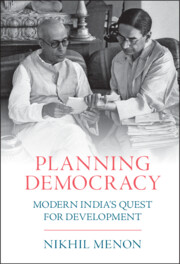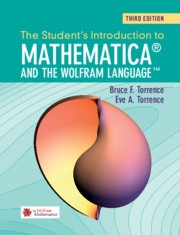Refine search
Actions for selected content:
42 results
Chapter 25 - The Technological Dimension
- from Part IV - Creative Engagements beyond Music
-
-
- Book:
- Boulez in Context
- Published online:
- 08 July 2025
- Print publication:
- 24 July 2025, pp 262-272
-
- Chapter
- Export citation
Computers for China: Technology Trade and the Transformation of the Cold War in East Asia, 1968-80
-
- Journal:
- Journal of Global History , First View
- Published online by Cambridge University Press:
- 23 June 2025, pp. 1-21
-
- Article
-
- You have access
- Open access
- HTML
- Export citation
A Theory of Consistency of Ordering Generalizable to Tailored Testing
-
- Journal:
- Psychometrika / Volume 42 / Issue 3 / September 1977
- Published online by Cambridge University Press:
- 01 January 2025, pp. 375-399
-
- Article
- Export citation
3 - Modeling the Economic System
-
- Book:
- Managing Growth in Miniature
- Published online:
- 24 October 2024
- Print publication:
- 07 November 2024, pp 102-140
-
- Chapter
- Export citation
Might text-davinci-003 Have Inner Speech?
-
- Article
-
- You have access
- Open access
- HTML
- Export citation
3 - Digital Divide among K-12 Students
- from Part I - Users in Cyber Behavior
-
-
- Book:
- The Cambridge Handbook of Cyber Behavior
- Published online:
- 06 December 2024
- Print publication:
- 09 November 2023, pp 39-96
-
- Chapter
- Export citation
38 - An Evaluation of Computational Modeling in Cognitive Sciences
- from Part V - General Discussion
-
-
- Book:
- The Cambridge Handbook of Computational Cognitive Sciences
- Published online:
- 21 April 2023
- Print publication:
- 11 May 2023, pp 1228-1249
-
- Chapter
- Export citation
5 - Logic-Based Modeling of Cognition
- from Part II - Cognitive Modeling Paradigms
-
-
- Book:
- The Cambridge Handbook of Computational Cognitive Sciences
- Published online:
- 21 April 2023
- Print publication:
- 11 May 2023, pp 173-209
-
- Chapter
- Export citation
Comparison of computerised and pencil-and-paper neuropsychological assessments in older culturally and linguistically diverse Australians – CORRIGENDUM
-
- Journal:
- Journal of the International Neuropsychological Society / Volume 28 / Issue 10 / November 2022
- Published online by Cambridge University Press:
- 10 October 2022, p. 1105
-
- Article
-
- You have access
- HTML
- Export citation
3 - Chasing Computers
- from Part I - Data
-
- Book:
- Planning Democracy
- Published online:
- 24 March 2022
- Print publication:
- 31 March 2022, pp 93-116
-
- Chapter
- Export citation

Planning Democracy
- Modern India's Quest for Development
-
- Published online:
- 24 March 2022
- Print publication:
- 31 March 2022
Epilogue
-
- Book:
- Performance and Modernity
- Published online:
- 09 December 2021
- Print publication:
- 06 January 2022, pp 249-269
-
- Chapter
- Export citation
Chapter 3 - Trust and Digitalization
- from Part I - Fundamental Level of Trust
-
-
- Book:
- The Neurobiology of Trust
- Published online:
- 09 December 2021
- Print publication:
- 16 December 2021, pp 54-76
-
- Chapter
- Export citation
Comparison of Computerised and Pencil-and-Paper Neuropsychological Assessments in Older Culturally and Linguistically Diverse Australians
-
- Journal:
- Journal of the International Neuropsychological Society / Volume 28 / Issue 10 / November 2022
- Published online by Cambridge University Press:
- 10 December 2021, pp. 1050-1063
-
- Article
- Export citation
Computer based psychiatric rehabilitation: current activities in Germany
-
- Journal:
- European Psychiatry / Volume 11 / Issue S2 / 1996
- Published online by Cambridge University Press:
- 16 April 2020, pp. 60s-65s
-
- Article
- Export citation
Schizophrenia: comparison of 13 diagnostic systems in a cross-sectional study1
-
- Journal:
- European Psychiatry / Volume 8 / Issue 1 / 1993
- Published online by Cambridge University Press:
- 16 April 2020, pp. 7-13
-
- Article
- Export citation
Psychiatrists meet on the web: the chance for a virtual congress. Results and experiences from the First International Internet Congress on Psychiatry 1997
-
- Journal:
- European Psychiatry / Volume 14 / Issue 1 / March 1999
- Published online by Cambridge University Press:
- 16 April 2020, pp. 57-62
-
- Article
- Export citation
Chapter 12 - Communicating in a web-based world
- from Part Two - Communicating in organisations
-
- Book:
- Communication Skills for Business Professionals
- Published online:
- 06 April 2020
- Print publication:
- 12 June 2019, pp 339-381
-
- Chapter
- Export citation

The Student's Introduction to Mathematica and the Wolfram Language
-
- Published online:
- 01 April 2019
- Print publication:
- 16 May 2019
A Relational Database as Decision Support System in Chemical Weed Control
-
- Journal:
- Weed Technology / Volume 10 / Issue 4 / December 1996
- Published online by Cambridge University Press:
- 12 June 2017, pp. 781-794
-
- Article
- Export citation
